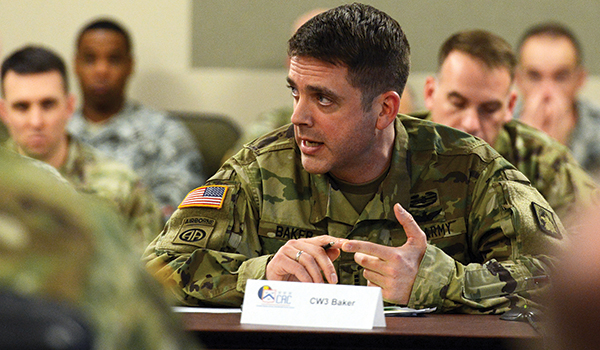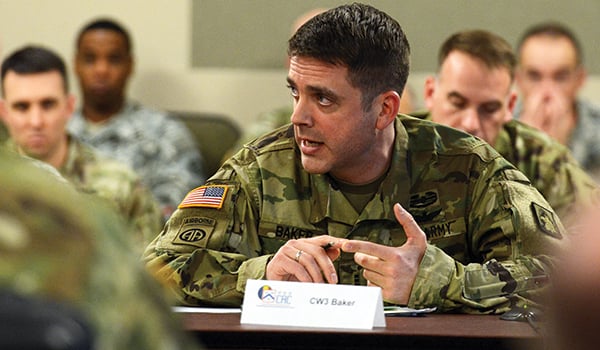
Chief Warrant Officer of the Branch / By CW5 Joseph B. Roland: As Army Aviation integrates changes driven by The National Commission on the Future of the Army, the Holistic Aviation Assessment Task Force (HAATF) Study, and Aviation Branch specific initiatives, I wanted to take some time to give you the “why” behind just a few of these changes.

CW3 James Baker presents his team’s findings to LTG Robert Brown, commander of the Combined Arms Center, during the first Warrant Officer Solarium, held at the Command and General Staff College, Fort Leavenworth, KS, Jan. 15, 2016. / U.S. ARMY PHOTO BY DAVID VERGUN, DEFENSE MEDIA ACTIVITY-ARMY
Aviation warrant officer recommended changes span our entire life cycle from initial accessions through CW5 utilizations and service terms. These changes are designed to foster the development of our aviation warfighters, sharpen their technical and tactical expertise, minimize turmoil, and ensure the health of our current and future formations. We must deliver to this Nation and our Army the innovative, agile, adaptive technical and tactical warfighters required to fight and win tonight and tomorrow.
WO1 Time in Grade (TiG) Extension
It was in 1993, one year after the Warrant Officer Leader Development Action Plan (WOLDAP) was signed into policy, that the Army began appointing WO1s after completion of the six week Warrant Officer Candidate School (WOCS) instead of after successful completion of 12-20 months of undergraduate (primary) and graduate (advance track) level flight training. This policy change had minimal effect on our Technical WOs as they entered WOCS with a basic level of competence and expertise in their MOS and attended relatively short Basic Courses. The effect of this policy change on the Aviation WO was profound. Because of the length of initial flight training, we are sending aviators to their first assignments with 14-20 months as a WO1, with a few arriving as newly promoted CW2s. Not only did this early appointment reduce the amount of developmental time in first utilization assignments, it also reduced the time for our CW2s to master their functional specialties before completion of their initial ADSO and CW3 promotion boards. There is no feeder route for Army Aviators – on average, an aviator will take four to six years to gain the technical and tactical expertise required for the specialized functional roles or tracks (IP/TACOPs/MTP/ASO) that Aviation WOs are responsible for. We have only one opportunity to establish a technical and tactical foundation from which to continue our professional development. For these reasons the HAATF recommended with G-1 approval a one year TiG extension for all Active Duty 152-155 MOS personnel.
Track +1
In order to manage personnel turnover, provide stability, and facilitate the initial development of newly tracked aviators, when able HRC should allow aviators to remain at their initial duty assignment an additional year after completion of a track producing course. This policy is not feasible for short-duration rotational assignments, and the needs of the Army will take precedence. The policy allows commanders and senior WOs to actively participate in the management and development of talent within their formations. Having newly tracked aviators return to their units to cut their teeth will reduce distractors caused by a new duty station relocation, local area orientations, SOP and administrative changes, and family integration.
Broadening within the Branch (Sharpening)
Managing and developing the WO population is critical to the success of this Branch and the relevancy of the WO cohort at large. DA Pam 600-3 Commissioned Officer Professional Development and Career Management defines “broadening” as a purposeful expansion of a leader’s capabilities and understanding. As specialized technical and tactical Warfighting experts, Aviation WOs will continue to develop through progressive assignments, PME, and by taking Branch required assignments within the Directorate of Training and Doctrine (DOTD) [Doctrine, Survivability, ASDAT, and Gunnery Branches], Capability Development and Integration Directorate (CDID) [TRADOC Capability Managers (TCMs) and Organization Personnel Force Development (OPFD)], combat training centers (CTCs), Warrant Officer Career College (WOCC), Aviation Warrant Officer Advanced Course (AWOAC), and Directorate of Evaluation and Standardization (DES). These assignments introduce, develop, and integrate our Aviation WOs into Army, Joint, and Branch level programs and processes. This exposure will enhance both technical and tactical expertise while developing a broader understanding of Army and Aviation Branch roles and responsibilities, while not diluting their core aviation competencies. A review of DA Pam 600-3 and all Aviation Warrant Officer Career Models is ongoing.
Active Duty Service Obligation (ADSO) and Active Federal Service (AFS) Changes
Army aviation personnel readiness has steadily declined due to attrition rates in excess of historical averages, an increased civilian demand for our technical expertise, and eight years of under-accessions. Increasing the ADSO and reducing the maximum AFS limit are two initiatives that will positively impact aviation manning and readiness, are sustainable, allow us to retain talent, and ensure a healthy future force. If aviator expertise requires 4-6 years to develop, an ADSO increase to 8 years will allow the Army to utilize that expertise prior to aviators completing their first service obligation.
Reducing the maximum AFS from 12 years (without waiver) to 8 years will increase aviator readiness with fewer aviators eligible for retirement at the completion of the flight school ADSO. Recent trends indicate an increased number of CW2s and junior CW3s retire at the completion of their flight school ADSO. Our accessions model selects a majority of applicants from in-service and has proven to select high-quality Soldiers, but it must be balanced to ensure longevity and stability for the Branch.
Senior leaders within the Army and our Branch understand the critical role warrant officers play within the force, and acknowledge the unique training and developmental needs of our Aviation WOs. The force is undermanned requiring each of us to row even harder. I wish I could say this will be short-lived but Aviation WO under-accessions will take years to recover from. As I said in my first article: “For the innovative and adaptive warfighter there has never been a better opportunity to improve your unit, yourself, and the Army.”
Thank you for all you do for this Nation and our Army; it’s an honor and privilege to serve with such professionals.
Above the Best!
CW5 Joseph B. Roland is the chief warrant officer of the Aviation Branch with the U.S. Army Aviation Center of Excellence, Fort Rucker, AL.








